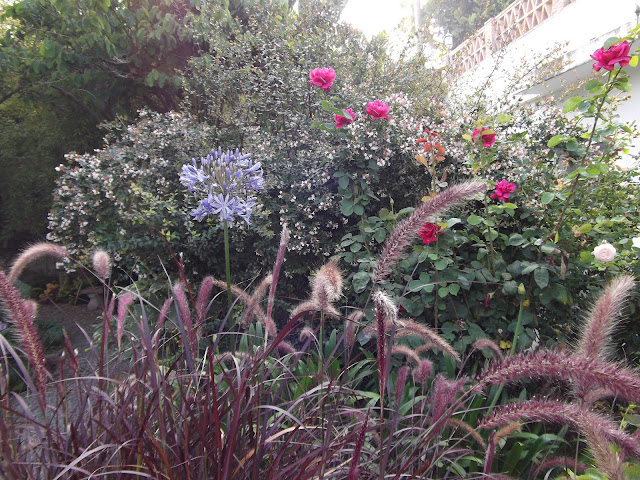Tuesday, July 2, 2013
Friday, June 21, 2013
Tuesday, June 4, 2013
Saturday, April 6, 2013
An early April Morning.....
The birds are singing, the sun is shining, the bees are humming in the orange trees and the weeds will be growing even faster today after yesterday's rain but the garden is a heavenly place......
 |
| Loropetalum |
 | ||||
| An oversized Lemon |
 |
| Alstroemeria |
 |
| Jasminum humile 'Rrevolutum' |
 |
| Rosa 'Climbing Crimson Glory' |
 |
| Alstroemeria |
Monday, March 25, 2013
Our Red Rumped Swallow brings a friend.....
Since last Wednesday, our 'Red Rumped Swallow' has been a frequent visitor to his perch in front of the mirror. Early morning and in the evening until it is too dark to see himself, and once or twice during the day, he tweets away to his reflection.
To our surprise, four mornings ago, he arrived with a friend who perched herself on top of the parrot's head alonside the mirror and sat watching our Red Rump. Goodness only knows what she made of it but...she eventually flew off and left him to it.
Since then, she has been a regular visitor, arriving with him and leaving with him, patiently waiting for him whilst he admires himself ......
Are they nest building we wonder....will her patience be rewarded?
Wednesday, March 20, 2013
The Return of the Red Rumped Swallow.....
Monday morning as soon as it was light enough to see, there he was, cheerfully singing away to himself in the mirror on our patio....
The last time he was here was the middle of September.
Where has he spent the winter?
Perhaps he flew across the Alboran sea to Morocco, it isn't so far from here.
Will he find a mate, rather than a mirror image, and settle down?
Only time can tell.
http://acostatropicalgarden.blogspot.com.es/2012/09/the-narcissistic-red-rump-swallow.html
Friday, March 8, 2013
After the March Rain......
We awoke to a beautiful clear sunny morning with not a cloud in the sky. Oh the sheer joy of it after a week or so of heavy torrential rain. The birds are singing in the tree tops, the avocado trees are full of blossom and our spirits are lifted. The sea is as flat as a mill pond this morning and as I watch, the Moroccan bound ferry is noisily signalling it's imminent departure.
We are more than ready for another Moroccan adventure but, meanwhile, whist we wait, there is much to keep us busy in this Costa Tropical Garden.
Up in the hills above Motril, the wild flowers will soon be abundant and at their best after all the rain.
March and April, the perfect months for visiting hill walkers, wild flower enthusiasts and Bird watchers here on the tropical coast of Spain.
Wednesday, February 20, 2013
Pancratium maritimum.........Sea Lily
There is a beach, usually deserted, just east of Motril Port named 'Playa Azucenas'.
This beach is linked to the legend of the appearance of the image of the Virgen de la Cabeza, patron saint of Motril.
The beach gets it's name from the Sea Lily.
The Sea Lily, Pancratium maritimum, is also known as Sand Daffodil or Sand Lily and the Lily of St. Nicholas.
In Castellano it is called Azucena marina, Nardo marino or Amor mío.
The flower has a pleasing, exotic and very subtle lily scent, which only becomes apparent during still, windless summer nights that allow its delicate fragrance to become perceptible.
This wild flower is an endangered member of the Amaryllidaceae family and as thus, is protected.
The sea lily inhabits the dunes and beaches of the coast and has adapted to survive with limited water. The white color and coating of hair are some of the most common plants that live in these ecosystems. Not only do they hold water but avoid losing them. The shape of the corolla atrompetada contributes to the maximum water collection, albeit in a spray form, vital for survival under these conditions.
Time past, the lilies were abundant on Motril's coast giving rise to the name, Beach of the Lilies but now the lilies and the beach are reduced by the expansion of the port.
Motril hopes that future generations will continue to know, appreciate and defend, this species now extinct in the natural habitats of the Granadino coast.
Subscribe to:
Posts (Atom)










































